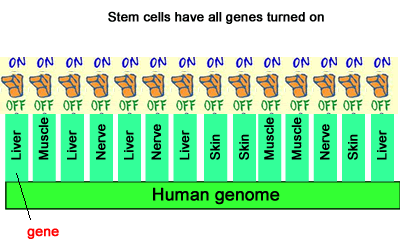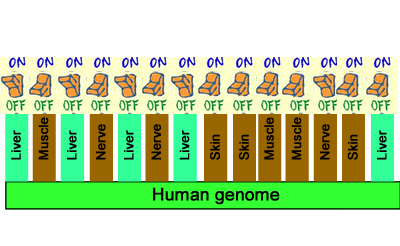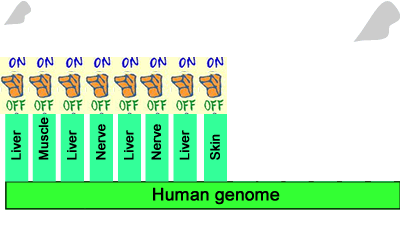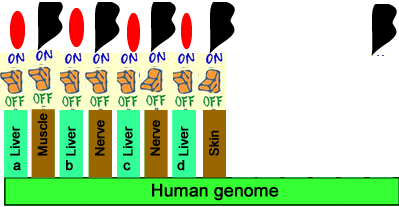All cells contain exactly the same genetic material and yet some specialise as skin cells, muscle cells and so on. Cell specialisation occurs because cells are able to express, or turn on, only a fraction of their genes while the others are turned off. The process of turning genes on and off is known as gene regulation.
Now before we go on. What is a gene? A gene is a small segment of DNA which contains coded information for the synthesis of a specific protein. Click for more information on protein synthesis. Each gene codes for just one protein. It is the proteins that control cell function and form.
Gene regulation is an important part of normal development. Genes are turned on and off in a coordinated fashion during development in order to make cells look and function as specialised cells, such as brain or nerve cells.
Signals from the environment or from other cells activate proteins called transcription factors which bind to regions of DNA close to the gene that attract proteins and literally switch the gene on or off by inhibiting or attracting the molecular machinery that allows for gene expression.
The mechanism by which transcription factors are able to regulate gene expression is complex and beyond the scope of this unit. So we will offer a simple explanation so the reader can gain a basic understanding of the work involved in transforming an adult cell into a stem cell.
Let's take a simple look at gene expression and keep in mind that the mechanism for suppressing or promoting gene expression, in reality, is not as simple as an on/off switch.
All somatic cells in the body have the same genetic material. Stem cells have the ability to express all genes so a stem cell can become any type of specialised cell.
The simple diagram on the right attempts to show the ability of the stem cell to activate all its genes.

A stem cell that has become specialised will have most of its genes switched off and only the genes associated with the particular specialisation switched on.
For example, a liver cell will have the genes that code for form and function of a liver cell switched on, as shown on the right.


Even in a specialised liver cell, some genes can be switched off when the protein they code for is not needed.
But the control of genes is a dynamic chemical process reacting to many signals to insure the healthy function of the cell and in a healthy liver cell, for example, genes still need to be turned on or off depending on the circumstances.
Just imagine a binge eating session of high sugar foods. The liver must respond by increasing certain metabolic functions that will enable the sugar to be taken out of the blood and strored. Proteins that will do this need to be produced in great number and here is where the genes that code for these proteins must be switched on and immediately the situation calms down switched off again.
